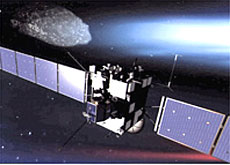
Comet chaser faces lengthy delay

Swiss scientists have expressed their disappointment at the delay of a €1 billion (SFr1.5 billion) European space mission to land a robot on a comet.
The Rosetta spacecraft, which carries an instrument designed at Bern University, was due to embark on its ten-year journey before the end of the month.
The European Space Agency (ESA) and its rocket operator, the Arianespace consortium, announced the project would be postponed because of lingering concerns about the reliability of the Ariane 5 launcher.
The mission, which should reveal much about how the solar system formed, will almost certainly have to be redesigned with a new target.
“It’s not totally unexpected but it’s still a big disappointment,” Rudolf von Steiger, director at the International Space Science Institute in Bern, told swissinfo.
“We had hoped that this mission would finally be launched to arrive at Comet Wirtanen in 2011. Now we have to wait and find another target.”
“On the other hand, it would have been too big a risk to launch this mission on the Ariane 5. Ariane 5 has not had a good enough record in its short history so far that we can put so many eggs in this basket at the moment.”
Mission control
It is a view shared by Swiss mathematician, Walter Flury, who heads the group which works out the trajectory calculations at mission control – the European Space Operations Centre (ESOC) in Darmstadt, Germany.
“Space missions are very complicated – in particular this one – and one has to be really sure that everything is okay before launching.”
The spacecraft was due to rendezvous with Comet Wirtanen in 2011, about 770 million kilometres from the Sun.
The original plan was for Rosetta to orbit around the comet and then drop a robot onto its icy nucleus.
Rosetta would need to have been launched before the end of this month to take advantage of the gravitational fields of Mars and the Earth to build up enough speed to catch Comet Wirtanen.
Lengthy preparations
Physicist Kathrin Altwegg and her team at Bern University have devoted the last seven years to the design and construction of one of the experiments aboard the craft.
The Rosetta Orbiter Spectrometer for Ion and Neutral Analysis (Rosina) is designed to use mass spectrometers to identify atoms, molecules and ions in a comet’s vapour.
The Swiss government contributed SFr38 million towards the SFr60 million costs of Rosina.
Altwegg said the delay was a blow but that Esa was considering all possibilities.
“They are now working on all options with a launch within the next two and a half years,” she told swissinfo.
New mission
An upgraded Ariane 5 rocket had to be blown up by remote control on its inaugural flight last month when it veered out of control after launch from Kourou in French Guiana.
Rosetta was due to be launched from a conventional Ariane 5.
Most scientists believe that another comet will have to be chosen but there could remain an outside chance of catching Wirtanen.
“There is a slim possibility to go to Wirtanen but fly a little bit faster with the upgraded Ariane 5,” said Altwegg.
“The launch window would be between ten and 12 months from now and we would arrive at Wirtanen at the same time as originally planned.”
Redesigning the mission is expected to add millions of euros to the cost.
The options will be presented in February and Esa’s science programme committee will make a formal decision in May.
swissinfo, Vincent Landon
Rosetta resembles a large aluminium box about 2.8 x 2.1 x 2.0 metres.
The spacecraft and its lander carry 21 experiments.
The scientific instruments are mounted on top.
The spacecraft alone has cost about €600 million (SFr876 million).

In compliance with the JTI standards
More: SWI swissinfo.ch certified by the Journalism Trust Initiative





























You can find an overview of ongoing debates with our journalists here . Please join us!
If you want to start a conversation about a topic raised in this article or want to report factual errors, email us at english@swissinfo.ch.